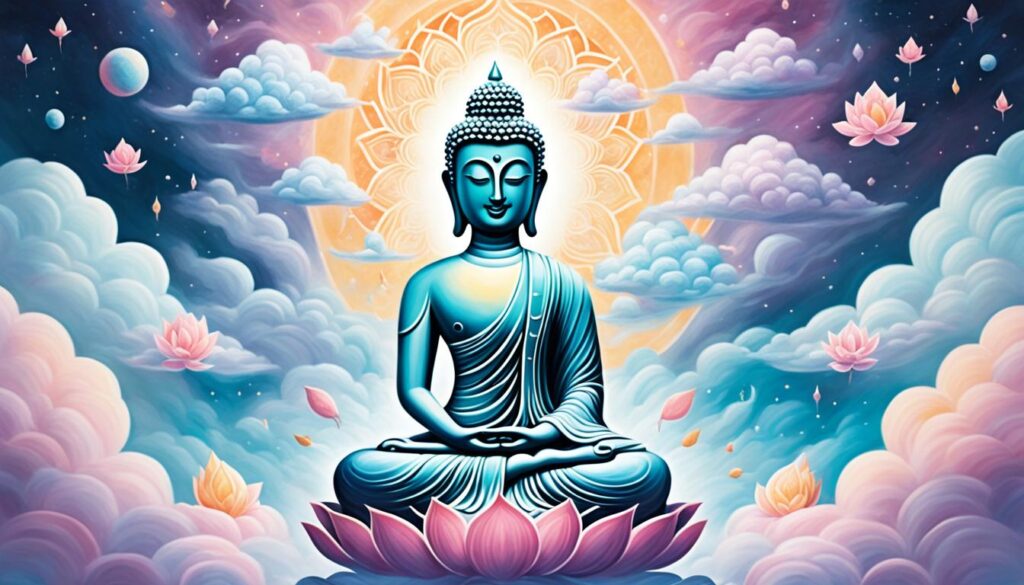Have you ever wondered how to find serenity in the chaos of life? How to experience a deep sense of peace and tranquility amidst the struggles and challenges of existence? Pure Land Buddhism may hold the key.
While Zen Buddhism has gained more prominence in the West, Pure Land Buddhism has quietly provided solace and refuge to countless individuals for centuries. Its teachings offer a unique blend of wisdom and self-reflection, exploring the nature of human existence and the potential for transformative awakening.
Key Takeaways:
- Pure Land Buddhism combines ancient wisdom with practical teachings for finding tranquility.
- Zen Buddhism may be more well-known, but Pure Land teachings have had a far-reaching impact.
- The practice of Pure Land Buddhism involves critical self-reflection and recognition of suffering.
- By embracing Pure Land teachings, you can discover hope, enlightenment, and personal harmony.
- Explore the transformative potential of Pure Land Buddhism and experience serenity in your own life.
The Scriptural and Commentarial Tradition
The teachings of Pure Land Buddhism find their origins in Mahayana scriptures that describe the existence of celestial buddhas and their buddha-fields across the vast expanse of the cosmos. These scriptures laid the foundation for the development of the concept of attaining birth in Amida Buddha’s Pure Land and liberation from the cycle of samsara. Originating in India, these teachings were later transmitted to China, where the Pure Land tradition flourished and accumulated an extensive body of scriptures and commentaries.
Pure Land teachings emerged from Mahayana texts that depicted the presence of buddhas and their celestial realms existing throughout the vast scope of the universe. The pursuit of rebirth in Amida Buddha’s Pure Land and liberation from cyclic existence originated in India before being transmitted to China. Over time, the Japanese Pure Land Buddhist tradition evolved with the accumulation of numerous scriptures and commentaries that form the foundational texts of this profound spiritual path.

Contours of Pure Land Buddhist Thought
Pure Land Buddhist thought encompasses a rich tapestry of ideas and concepts that delve into the core aspects of human existence. It encourages critical self-reflection and invites individuals to recognize the inherent suffering in life, while providing pathways to liberation and enlightenment through the practice of Pure Land Buddhism.
One important facet of Pure Land Buddhist thought is the notion of merit transference. The transfer of merit involves the dedication of one’s virtuous actions and positive intentions to benefit all beings. This practice fosters compassion and cultivates a sense of interconnectedness among individuals.
Furthermore, Pure Land Buddhist thought acknowledges the existence of cosmic Buddhas and buddha-fields. These celestial realms, inhabited by enlightened beings, serve as sources of inspiration and aspiration for practitioners. By placing their faith and trust in the cosmic Buddhas, individuals seek rebirth in the Pure Land, a realm where they can continue their spiritual journey towards ultimate enlightenment.
It is important to note that Pure Land Buddhist thought encompasses both monastic and lay practitioners. While monastic individuals dedicate their lives to rigorous spiritual practices within the confines of monastic settings, lay practitioners engage with Pure Land teachings and practices in the midst of their daily lives. This inclusion of both monastic and lay perspectives emphasizes the accessibility and relevance of Pure Land Buddhism to people from all walks of life.

The Path of Critical Self-Reflection
One of the key aspects of Pure Land Buddhist thought is the emphasis on critical self-reflection. Through introspection and contemplation, practitioners are encouraged to examine their thoughts, emotions, and actions with honesty and clarity. This critical self-reflection allows individuals to recognize their own limitations, attachments, and delusions, ultimately leading them towards spiritual growth and transformation.
Merit Transference and Compassionate Action
Merit transference plays a vital role in Pure Land Buddhist thought as it enables practitioners to extend their positive intentions towards the welfare of all sentient beings. By dedicating their merits to others, individuals cultivate a compassionate mindset and actively contribute to the alleviation of suffering in the world. This practice fosters a sense of interconnectedness and encourages individuals to engage in acts of empathy, kindness, and generosity.
Cosmic Buddhas and the Pure Land
Central to Pure Land Buddhist thought is the belief in the existence of cosmic Buddhas and the Pure Land, a realm of peace and enlightenment. Cosmic Buddhas are enlightened beings who have attained liberation and reside in celestial dimensions. The Pure Land, presided over by Amida Buddha, represents an ideal realm where individuals can be reborn and continue their spiritual journey towards liberation. The contemplation of cosmic Buddhas and the Pure Land serves as a source of inspiration and aspiration for practitioners.
Inclusive Engagement of Monastic and Lay Practitioners
Pure Land Buddhist thought recognizes the unique contributions and roles of both monastic and lay practitioners. Monastics dedicate their lives to intense spiritual practices and serve as spiritual guides and teachers. Lay practitioners, on the other hand, engage with Pure Land teachings amidst their ordinary lives, applying its principles and cultivating compassion in their daily interactions. This inclusive engagement of both monastic and lay individuals reinforces the idea that the path to liberation is accessible to all, regardless of their societal roles or commitments.
| Key Ideas | Description |
|---|---|
| Critical Self-Reflection | Encouragement to examine one’s thoughts, emotions, and actions for spiritual growth and transformation. |
| Merit Transference | The dedication of virtuous actions and positive intentions towards the benefit of all beings. |
| Cosmic Buddhas and Pure Land | Belief in the existence of enlightened beings and an ideal realm of peace and enlightenment. |
| Inclusive Engagement | Recognition of the roles and contributions of both monastic and lay practitioners in Pure Land Buddhism. |
Japanese Pure Land Buddhist Thought
In the realm of Japanese Pure Land Buddhism, a groundbreaking perspective on Nembutsu emerges as a practical practice transmitted by the revered figure, Hōnen. The Nembutsu, which involves the heartfelt recitation of Amida Buddha’s name, unfolds as a transformative path towards salvation and rebirth in the Pure Land. Hōnen’s profound teachings on Nembutsu have left an indelible mark on the development of Japanese Pure Land Buddhism.
As Hōnen elucidated the Nembutsu as a means of connecting with Amida Buddha’s immeasurable compassion, it sparked a shift in the understanding and practice of Pure Land Buddhism. By embracing the Nembutsu as a praxis, adherents find solace, transcendence, and the potential for attaining enlightenment. This revolutionary approach emphasizes the accessibility and inclusivity of the Pure Land teachings, making them available to all who sincerely engage with the Nembutsu.
Through the power of recitation, individuals establish a profound connection with Amida Buddha, invoking his benevolent presence and drawing closer to the ultimate goal of spiritual liberation. The Nembutsu practice becomes a spiritual refuge, a steadfast means of navigating the challenges of existence and experiencing the transformative embrace of Amida Buddha’s unconditional love and wisdom.
The Teachings of Hōnen
Hōnen’s teachings on Nembutsu brought about significant shifts within the landscape of Japanese Pure Land Buddhism. His emphasis on the fundamental importance of faith and reliance on Amida Buddha’s vow resonated deeply with followers, offering a profoundly accessible path in an era of growing adversity.
One central aspect of Hōnen’s teachings was the recognition of the problematic nature of self-power practices, which relied on an individual’s personal efforts alone to achieve spiritual liberation. Instead, he highlighted the power of Other Power, recognizing the immeasurable compassion and salvific vow of Amida Buddha as the primary means through which liberation is attained.
Hōnen’s teachings also ignited contemplation on the nature of birth in the Pure Land. He emphasized the importance of a sincere and devoted engagement with the Nembutsu, underscoring the transformative potential of this practice as a catalyst for rebirth in the realm of Amida Buddha.
The Influence of Hōnen’s Teachings
Hōnen’s teachings had a profound impact on the development and evolution of Japanese Pure Land Buddhist thought. They sparked a vibrant Dharma movement known as Jōdo Shū, which emphasized the significance of reciting the Nembutsu as a central practice in attaining awakening and liberation.
In addition to inspiring a new generation of followers, Hōnen’s teachings also generated significant controversy and debate within the Buddhist community. This led to the formation of various lineages and schools of thought within Japanese Pure Land Buddhism, each offering their unique interpretations and approaches to the Nembutsu praxis.

The image above depicts Hōnen imparting his wisdom on the Nembutsu, exemplifying his instrumental role in shaping Japanese Pure Land Buddhist thought.
Philosophical Issues in Japanese Pure Land Buddhist Thought
Japanese Pure Land Buddhist thought delves into a myriad of philosophical questions, exploring the profound complexities of existence and the ethical implications it entails. From contemplating the nature of reality to unraveling the depths of human existence, Pure Land teachings stimulate introspection and invite analysis.
One aspect of philosophical inquiry within Pure Land Buddhism is Pure Land Buddhist metaphysics. It involves contemplating the fundamental nature of reality and the interplay between the material and spiritual realms. By exploring the metaphysical dimensions of Pure Land teachings, practitioners seek a deeper understanding of the cosmos and their place within it.
Another area of philosophical exploration is Pure Land Buddhist anthropology. This branch of inquiry investigates the nature and essence of human existence, posing questions about the purpose of life, the human condition, and the potential for spiritual growth. It encourages individuals to reflect on their place in the world and the development of compassionate wisdom.
Pure Land Buddhist hermeneutics is also crucial to philosophical inquiry. It concerns the interpretation and understanding of Pure Land scriptures, texts, and commentaries. Through hermeneutics, practitioners analyze and unlock the deeper layers of meaning within the teachings, seeking insights that can guide their spiritual journey.
Finally, Pure Land Buddhist ethical reflection encompasses the contemplation of ethical principles and moral conduct within the context of Pure Land teachings. It encourages individuals to examine their intentions, actions, and relationships to foster compassion, wisdom, and harmonious living.
Contours of Philosophical Issues in Japanese Pure Land Buddhist Thought
| Philosophical Issues | Description |
|---|---|
| Pure Land Buddhist Metaphysics | Contemplation of the fundamental nature of reality and the interplay between the material and spiritual realms. |
| Pure Land Buddhist Anthropology | Inquiry into the nature and essence of human existence, including the purpose of life and the potential for spiritual growth. |
| Pure Land Buddhist Hermeneutics | Study and interpretation of Pure Land scriptures, texts, and commentaries to uncover deeper layers of meaning. |
| Pure Land Buddhist Ethical Reflection | Reflection on ethical principles and moral conduct within the context of Pure Land teachings. |
Engaging with these philosophical issues deepens the understanding of Pure Land Buddhism and provides practitioners with a holistic framework for personal and spiritual development.
Japanese Pure Land Buddhism’s Encounter with Modernity
As Japanese Pure Land Buddhism navigated the winds of modernity, it faced both challenges and transformation.
One notable critique came from Christian perspectives, questioning the reliance on Amida Buddha’s grace for salvation. Critics argued that faith in a single deity undermined individual agency and moral responsibility. However, proponents of Pure Land Buddhism countered by emphasizing the compatibility of Amida’s infinite compassion with human endeavor and ethical engagement.
Furthermore, Japanese Pure Land Buddhism experienced an intellectual reform and modernization movement in response to the changing social and cultural landscape. Buddhist scholars and practitioners sought to update traditional teachings to resonate with modern sensibilities, making them more accessible and relevant to contemporary society.
An existential engagement emerged within Pure Land Buddhism, as practitioners explored the concepts of human existence, suffering, and salvation in the face of modern challenges. Amidst the complexities of urbanization, globalization, and rapid technological advancements, Pure Land Buddhist thought provided a framework for individuals to find solace and meaning within the tumultuous landscape of modern life.
The existential engagement with Pure Land Buddhism not only addressed individual concerns but also encompassed broader societal issues. The teachings emphasized compassion, ethical action, and collective well-being, fostering a sense of interconnectedness and social harmony.
In today’s fast-paced world, where spiritual longing coexists with the demands of modern life, Japanese Pure Land Buddhism offers a sanctuary of tranquility and a path to existential fulfillment. It continues to evolve and adapt, remaining a relevant and empowering force for those seeking solace, enlightenment, and meaningful engagement in the present age.

| Christian Critique of Pure Land Buddhism | Modernization of Buddhist Thought | Existential Engagement with Pure Land Buddhism | |
|---|---|---|---|
| Impact | Questioned reliance on Amida Buddha’s grace for salvation | Updated traditional teachings to resonate with modern sensibilities | Explored concepts of human existence, suffering, and salvation in the face of modern challenges |
| Response | Emphasized compatibility of Amida’s compassion with human endeavor and ethical engagement | Adapted teachings to make them more accessible and relevant to contemporary society | Provided a framework for individuals to find solace and meaning in modern life |
| Social Impact | Addressed concerns of individual agency and moral responsibility | Fostered a sense of interconnectedness and social harmony | Emphasized compassion, ethical action, and collective well-being |
Conclusion
Pure Land Buddhism offers individuals a profound and transformative path to tranquility, hope, and spiritual refuge. Through the fusion of deep wisdom and critical self-reflection, it acknowledges the inherent challenges of human existence and provides a gateway to solace, enlightenment, and a profound understanding of personal and societal harmony.
By embracing Pure Land teachings, you can embark on a journey that transcends the limitations of everyday existence. The practice of reciting Amida Buddha’s name, known as Nembutsu, offers a practical and accessible means to attain rebirth in the Pure Land, a realm of transcendent enlightenment and pure bliss.
Furthermore, Pure Land Buddhism encompasses both monastic and lay practitioners, fostering a sense of inclusivity and providing spiritual guidance to individuals from all walks of life. It invites you to connect with the cosmic Buddhas and engage in the transfer of merit, ultimately leading to your own liberation from the cycle of suffering and rebirth.
As you delve into the philosophical depths of Pure Land Buddhist thought, you will encounter a rich tapestry of metaphysics, anthropology, hermeneutics, and ethical reflection. It offers a profound exploration of reality, human existence, scriptural interpretation, and ethical conduct, inviting you to deepen your understanding and transform your way of being in the world.
FAQ
What is Pure Land Buddhism?
Pure Land Buddhism is a form of Mahayana Buddhism that originated from ancient Indian texts and developed in China before being transmitted to Japan. It emphasizes the recitation of Amida Buddha’s name (Nembutsu) as a path to salvation and rebirth in the Pure Land.
How does Pure Land Buddhism differ from other forms of Buddhism?
Pure Land Buddhism focuses on the aspiration to be reborn in Amida Buddha’s Pure Land, where enlightenment is assured. Unlike other forms of Buddhism that emphasize meditation and self-discipline, Pure Land Buddhism places greater emphasis on faith in Amida Buddha and the recitation of his name.
Can anyone practice Pure Land Buddhism?
Yes, Pure Land Buddhism is open to anyone who wishes to seek enlightenment and rebirth in the Pure Land. It is equally accessible to monastic and lay practitioners, as it does not require extensive knowledge or specialized training.
What is the purpose of reciting Amida Buddha’s name?
Reciting Amida Buddha’s name, known as Nembutsu, is believed to establish a connection with Amida Buddha. This practice is seen as a way to express gratitude for his compassion and to deepen one’s faith in the aspiration to be reborn in the Pure Land.
Is Pure Land Buddhism compatible with other religions?
Pure Land Buddhism can be practiced alongside other religious traditions without conflict. It is not exclusivist and can be seen as a complementary spiritual practice that brings tranquility, hope, and spiritual refuge.
How does Pure Land Buddhism address the challenges of modernity?
Pure Land Buddhism has encountered criticism from Christian perspectives and has undergone intellectual reform and modernization. It also engages with existential issues in contemporary society, offering solace and guidance in the face of challenges and complexities.
Can Pure Land Buddhism bring peace and harmony to individuals and society?
Yes, Pure Land Buddhism offers individuals a path to tranquility, hope, and spiritual refuge. By embracing Pure Land teachings and practices, one can find solace, enlightenment, and a deeper understanding of personal and societal harmony.

